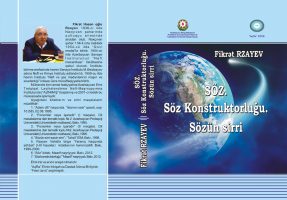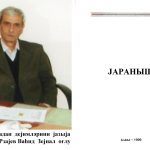MEANING-FORMING DUTIES AND FEATURES OF THE PHONEMES IN WORDS

MEANING-FORMING DUTIES AND FEATURES
OF THE PHONEMES IN WORDS
Vowel phonemes mainly serve for directing or aiming the motion of a thing or the other kinds of events indicated by consonant phonemes within the word. Their meaning-forming duties and features are as followings:
А /a/ ¾ 1) indicates features implying volume, capacity, empty space or space full of matter, substance (in fact there is not absolute emptiness in any place of the universe);
2) indicates the feature of capaciousness;
3) indicates the feature of a definite surface;
4) indicates the feature of one point-object-subject;
5) indicates the feature of unilinear direction;
6) indicates the feature of science, knowledge, Divinity, writing, voice;
7) can indicate the feature of place being used in the end of word;
8) can introduce the word as noun or other part of speech being used in the end of word.
O /o/ ¾ can feature any (only) single point-object, one thing, an outside person not participating in conversation (III person in singular), or one event.
U /u/ ¾ 1) can feature separate position of two points-objects, distance between them, remoteness;
- can feature existence of period, time between events, greatness, being long-time;
- can feature periodicity (cyclicity), i.e. continuation of event starting from one point, from one place, its advancement and then completion, ending having returned to the same point again.
E /e/ ¾ can feature in words direction, aiming of the event, of the process from the previous consonant phoneme towards the next consonant phoneme after this /e/ phoneme. Lets pay attention to two special situations here:
- if the /e/ phoneme is at the beginning of the word, then direction of processes or events starts from this phoneme and turnes to the events featured by the next phoneme after the /e/;
- if the /e/ phoneme is at the end of the word, then direction of processes or events is going to collaps or is turned towards the words following this current word.
Ə /ə/ ¾ 1) specifies the feature of turn of direction of process or event from the consonant phoneme after /ə/ phoneme towards the consonant phoneme staying before it; here we should pay attention to such a peculiarity that, if the /ə/ phoneme is at the beginning of the word, direction of the events is turned either towards the thing (event) itself, or towards the word staying before the current word or towards speaker’s idea;
2) historically in many words the /ə/ phoneme used to replace the /а/ phoneme and, correspondingly, its duties and features.
İ /i/ ¾ 1) another thing exists or another event occurs within (inside) one thing, place or event; (here we should pay attention to such a peculiarity that, these two occurring inner events may be organically related or not related to each other, i.e. they may occur depending on different origins or reasons);
- it can feature belonging, peculiarity (belonging to itself) (in many cases this feature is expressed when the phoneme is at the end of word);
3) in some words it features multiplicity as well.
I /ı/ ¾ (in contrary to directions in the features expressed by the / i / phoneme) features direction of thing or event coming off one thing, place or event, or its effort to move away; in some cases it can feature occurrence of opposite powers and frictions or obstacles during such effort.
Ü /ü/ ¾ features occurence or manifestation of unilinear events face to face, in straight direction or organically.
Ö /ə:/ ¾ can feature a thing or event located in front of a thing; here we should pay attention to the following peculiarities:
- thing or event staying in front does not moves away or nearer being motionless;
- thing or event staying in front moves away or comes nearer;
- the thing is in speaker, narrator or orator himself or the event occurs in himself.
So that to explain to the reader the main duties and features of consonants in simple way, and taking into account a number of other characteristics, they have been classified in nine groups having own titles. They are presented in the Table 1.
Table 1
| Group № | Groupe Title (main relative words) | Number of the Phonemes in Group | Phonemes
(consonant sounds) |
| I | GET | 1 | L |
| II | NATURE | 4 | b, v, p, f |
| III | FIRE | 5 | d, t, y, g /ɡj/, c /dʒ/ |
| IV | LIGHT-SOUND | 3 | s, z, j /ʒ/ |
| V | INSIDE | 3 | ç /tʃ/, k (backer articulation), ş /ʃ/ |
| VI | INSTANT | 1 | n |
| VII | ALSO | 1 | m |
| VIII | AR | 1 | r |
| IX | AH | 5 | q, k (fronter articulation), ğ /ɡh/, x /x/, h |
Besides, the consonant phonemes included in these groups, the subgroups and their meaning-forming duties and features are given in the Table 2.
Analysis of above stated duties and features of the phonemes on basis of typical words and concepts indicates that they express in words physical, geometrical. psycological notions and events and those concerning the wildlife.
Range of physical concepts and events includes such factors as space, time-period, distance, direction, different influences, work, power, different states of energy and being relatively valuable and etc.
Space concept covers such features as being in one point, in one place (a, ə /ə/, o, v phonemes), instant–space (n phoneme), place (r phoneme), inside-inner (ç /tʃ/ phoneme), surface of a place (a, q /ɡ/, k phonemes) and its edge (q, k phonemes), volume, space, comprehensiveness (a phoneme).
Table 2
Meaning-Forming Duties and Features
of the Consonant Phonemes in Words
| Group
№ |
Concept – the words characterizing the group | Fo
(consonant phonemes) |
Concept or feature No | Relative words characterizing the phonemes: appropriate relative concept ¾ appropriate features |
| 1 | 2 | 3 | 4 | 5 |
| I | Get (Be) | l /l/ | 1.1 | To “Be”(“Get”) – the factual feature; |
| 1.2 | To “Do” – the factual and verbal feature; | |||
| 1.3 | “Supreme” (multiple, upper, high, big, supreme, great and etc. features); | |||
| 1.4 | “Red” the state (colourful world), feature; | |||
| 1.5 | “Science” ¾ features meaning knowledge, sense, language, Divinity. | |||
| II | NATURE | b /b/ | 2.1.1 | “firm” ¾ expression of hardness, integrity, unity, resolution; features of object names considered significant in common use; in explanation of events quickly or clearly catching the eye in life |
| 2.1.2 | “ever” (also) ¾ the features of sameness, equality, twofold condition, multiplicity; the features of hardness, wholeness, consolidation | |||
| 2.1.3 | “nature” ¾ the objects of wildlife | |||
| v /v/ | 2.2.1 | “vector” ¾ some event or thing moves away from one point, from one place or moves nearer to them, or occurs at the same place; | ||
| 2.2.2 | “time, duration” ¾ events occur during time, a while or period; the events are with changes. | |||
| p /p/ | 2.3.1 | “every” ¾ the features of identity; multiplicity and forming unity by consolidation; | ||
| 2.3.2 | “bad” ¾ the features of badness, disorder of things and events; | |||
| 2.3.3 | “flat” ¾ the feature of flatness of things. | |||
| f /f/ | 2.4.1 | the concept meaning “performance”, “expression”; | ||
|
|
2.4.2 | the concept meaning “frail” ¾ relation between thing or events is disturbed, unstable; there appear separations, vacuousness; the events are speedy and cursory; today’s realities lead for futility, vacuousness tomorrow. | ||
| III | FIRE | d /d/ | 3.1.1 | “bearing” ¾ the state of being subject to big influences, pressures, persistations; firmness, endurance becomes apparent; |
| 3.1.2 | the events meaning “did”, “does”, “will do” corresponding with the verb “to do”; | |||
| 3.1.3 | “age” ¾ the feature appropriate to time; | |||
| 3.1.4 | “fiery-live” ¾ the concepts asocciated with wildlife. | |||
| t /t/ | 3.2.1 | “contact-touch” ¾ light or remote influence; | ||
| 3.2.2 | the fact or verb of “do”ing; | |||
| 3.2.3 | “heat-time” ¾ the feature appropriate to time or heat; | |||
| 3.2.4 | in words connected with wildlife accociated with “grassy or meat food” | |||
| 3.2.5 | “inner-t alternation”. | |||
| y /j/ | 3.3.1 | to “bend” ¾ hint to vitality in thing or in its motion; | ||
| 3.3.2 | “life” ¾ the feature of vitality necessary in life; | |||
| 3.3.3 | “separate” ¾ а) remoteness of objects or their movement away or their separate condition; features of expense of energy for their approaching as well;
b) accept of /y/ sound when affix is connected to root of word ending with vowel; c) when the words ending with /k/ accept the affix starting with vowel, the /k/ sound is replaced by /y/ sound. |
|||
| g /ɡj/ | 3.4.1 | “power” ¾ when there is powerfulness, brightness, abundant inner force and powers in things or events; | ||
| 3.4.2 | “boast” ¾ the features of strong overstating, boasting. | |||
| c /dʒ/ | 3.5.1 | “excited” ¾ the features of fervency, bellicosity, demostration of powers, physical dynamics, potential energy and its expense; | ||
| 3.5.2 | “slight” ¾ the features of little, minor energetic events; | |||
| 3.5.3 | “being” ¾ the features of energy, life, power, state in creatures; | |||
| 3.5.4 | “energy-time-period” features. | |||
| IV | LIGHT-SOUND | s /s/ | 4.1.1 | “slight influence” ¾ the feature of internal or external powers with relatively slight influence; |
| 4.1.2 | “Light-sound-heat” ¾ the features of Light (Radiance), sense, heat, time, sound; | |||
| 4.1.3 | “family-connection” ¾ the feature of creating unity, connection; | |||
| 4.1.4 | “ç /tʃ/-s alternation” ¾ historically in some words the ç /tʃ/ sound was replaces by the /s/ sound; | |||
| 4.1.5 | “su” ¾ the feature associated with water. (light within water, the number of the Great Creator’s White Light Particles is big). | |||
| z /z/ | 4.2.1 | “earthquake” ¾ the feature of vibrating power, having medium values comparatively with the feature of /s/ phoneme; the sounds are buzzy; it features manifestation, display. | ||
| 4.2.2 | “ plural affix “iz”” ¾ more powerfull, special state of “family-connection” notion as in the /s/ phoneme. | |||
| j /ʒ/ | 4.3.1 | “rustle” ¾ the feature of influence of internal, inner dynamical powers (in this case as if the energy has reached the highest parameters); | ||
| 4.3.2 | “thirst” ¾ the features of human characters, peculiarities such as craving to live, ardour, avidity, rudeness, horror and etc. | |||
| V | INSIDE | ç /tʃ/ | 5.1 | “Inside” (inner) ¾ inside features of place, thing and event itself. |
| k /k/ | 5.2 | the features meaning “Inner justice”, “Inner power”. | ||
| ş /ʃ/ | 5.3.1 | “waterfall” ¾ the feature of severity of internal events, powers, energy, feeling; | ||
| 5.3.2 | “double” ¾ the feature of creating inside doubleness, multiplicity entering inside. | |||
| VI | INSTANT | n /n/ | 6.1.1 | “instant” ¾ the features of space and time; |
| 6.1.2 | “comprehension” ¾ the feature meaning “to understand”; | |||
| 6.1.3 | the feature meaning “human”; | |||
| 6.1.4 | “address” ¾ the feature of directing to anything, to anywhere, entering or going out of there; | |||
| 6.1.5 | the feature meaning “negation”; | |||
| 6.1.6 | the feature meaning “object” (thing, mateial, bodily or spiritual creature). | |||
| VII | ALSO | m /m/ | 7.1.1 | “also” or “corresponding” ¾ the feature of existing at the same point, at the same place or life; relation, correspondence, analogy between things and events; |
| 7.1.2 | “means” ¾ the job is done by means of something. | |||
| VIII | АR | r /r/ | 8.1.1 | “place” ¾ the features of any place, geographic place, place of thing or space where events occur; |
| 8.1.2 | “ray” ¾ the concepts and features corresponding to other kinds of mechanical power, light, heat and energy; | |||
| 8.1.3 | “erа” ¾ the features of time-period; | |||
| 8.1.4 | “spirit” ¾ the feature of spirit, sense and intellect; | |||
| 8.1.5 | “being” ¾ the features meaning human, animal, “everybody”, “everything”. | |||
| IX | АH | q /ɡ/ | 9.1.1 | the features meaning “Just-God”, “justice-right” or ”power”; |
| 9.1.2 | “edge” ¾ the features of edge of a thing, of surface or brink line of a place; | |||
| 9.1.3 | “creatures” ¾ the features of creatures and their reproductions. | |||
| k` /k`/ | 9.2 | (the same as the features of q /ɡ/ phoneme). | ||
| ğ /gh/ | 9.3 | “roaring” ¾ the feature of events to undergo change when moving from one environment to another (“babbling”, “wrapping” of events, roaring of voices, “irritation” of forces and etc.). | ||
| x /x/ | 9.4.1 | “flow” ¾ flow of events of great force, state of not staying in one place, the features of participation, dynamic in events; | ||
| 9.4.2 | “fine” ¾ the feature of having good psychological state; | |||
| 9.4.3 | “spoiling” ¾ the feature of spoiling of things, events or psychological state. | |||
| h /h/ | 9.5.1 | the feature meaning “environment”; | ||
| 9.5.2 | the feature meaning “state”. |
Some part of Azeri words interpreted in the book
In the word “ad” [ad] (name) the а phoneme: features one point-object or point-subject, also having the features of knowledge and science, capaciousness or comprehensiveness can introduce the word as noun; the d phoneme (for a thing, object, subject that has name) has the feature of firmness and endurance. Therefore, generally it is possible to give name to any matter, thing, event or creature.
“Аç-mаq” [atʃ `maɡ] (to open) ¾ is a verb; here the а phoneme means unilinear direction of opening of something, for instance, of a door, and the ç /tʃ/ phoneme means inside (inner). So, it becomes possible to interfere inside, interior of something (itself) by pulling, pushing something in opposite direction (for instance, the door of room, the lid of chest) or conducting other appropriate operation, thus, the phoneme features of the word “аç” [atʃ] conform to these.
In the word “ip” [ip] (rope, cord, string) (a noun) the p phoneme indicates the feature of identity or multiplicity under the ever concept (tying of two ends of cord to two points or winding round something by length). [We should note that, the word “ip” also expresses the feature of length of the thing basing on the feature of the i phoneme to creat multiplicity; opposite variant of this word is pi (p in mathematics) which expresses the feature of compactness, assembling in one place].
In the word “ada” [a`da] (island) (a noun) the first a phoneme expresses one point, one place, surface of one area, and the d phoneme expresses the features of firmness, steadiness under the bearing concept (towering of the island above water and impossibility to go beyond the bounds ¾ to water), endurance (insolubility of the rocks making the island in water during the long time), stop of events (occurence only within the island, overland), and the last a phoneme expresses the place concept alongside with the noun generation feature.
In the verb “gör–mək” [ɡo:r`mək] (to see) the g phoneme expresses the feature of power (seeing ability of eye), the ö [o:] phoneme – the feature of being in front of eye, the r phoneme – both feature of place (of seeming object) and the feature of seeing (human or animal) under the being concept and the feature of light going from seeming object to the eye under the ray concept. We should note that, when we say “some person’s (scientist’s) opinion (point of view)”, the r phoneme in the word “gör” here imparts the feature of mind, intelligence under the spirit concept.
In the verb “gül–mək” [ɡül`mək] (to laugh) the g phoneme (fronter articulation of /ɡ/) indicates interpretation of the feature of brightness, abundant inner energy in loughing person under the power concept, the ü /ü/ phoneme – the feature of straight direction directed to laughter object, the l phoneme – both the feature of be-ing of the previous event, the feature of do-ing (implementing laughter incident), and the feature of demonstration of mind-intelligence, knowledge of laughing person (extent of these features is significant in laughter process) under the science concept.
In the word “boru” [bo`ru] (pipe) the b phoneme indicates both the feature of entry in sameness (invariability) and multiplicity (along circle and length of inner and outer surfaces) under the ever concept, and the feature of hardness, unity and integrity under the firm concept, the o phoneme indicates the features of unity of the pipe and its gap (its integrity along its sides), the r phoneme – the features of lengthwise position of place – gap under the place concept, and the u phoneme – the features of length of the pipe; besides, ru part of the word shows ability of any substance (liquid, gas) to swash (r) through the pipe with energy, pressure (r) to the long distance (u) under the ray concept.
In the word “saat” [sa`at] (watch, clock) the s phoneme indicates the feature of influence of relatively little external (the power needed for operation of the watch) and internal (for turning, movement of parts in mechanism) power and its result under the slight influence concept, the a phoneme indicates the feature of unilinear development, movement direction (movement of the hand and indication of the figures by it), the second a phoneme indicates repetition of the features of the previous a phoneme, and the t phoneme indicates the feature of time under the heat-time concept.
In the word “arхayın” [arxa`jin] (confident, convinced, assured) the previous and the next a phonemes explain the feature of unilinear direction, the r phoneme – the feature regarding spirit, sense and intellect under the spirit concept, the х /x/ phoneme – the feature of accumulation of events in one place and participation in them (at least by intelligence) under the flow concept; “rх” /rx/ part of the word can indicate nonexited, patient state of spirit, mind in higher concepts; the y /j/ phoneme is in connector role between the a phoneme and the ı /ı/ phoneme; the ı /ı/ phoneme replaces the i sound according to the low of vowel harmony, and it expresses the feature of direction in inside or to inside; n phoneme depending on the place of use of the word mainly can indicate the human, the comprehension, in some situations the address or the thing concepts. [As we see here, it is not correct to define the meaning of the word “arхayın“ by the word “arхa“ [arxa] (back) with the place meaning].
In the word “behişt” [be`hiʃt] (paradise) the b phoneme expresses the feature of living creation (human) under the nature concept, the h phoneme – the feature of environment and states in the paradise, the e phoneme – the feature of direciton of getting to this environment, to these states from natural world, the i phoneme – existing inside (within paradise), the ş /ʃ/ phoneme – the feature of severeness of paradice events and of state of feeling them under the waterfall concept, the t phoneme – the feature of occurrance of events towards inside, in interior of the paradise under the “t-inside alternation” concept and the feature of influence felt also from distance in the paradise under the contact-touch concept.
In the word “vahid” [va`hid] (only, sole; just one) the v phoneme indicates the feature of being in one point or approaching to it in state and movement under the vector concept, the a phoneme – the feature of point, the h phoneme – the feature of state; “vah” part of the words expresses the meaning of “being in one point or approaching to it”; the i phoneme shows the feature of inner (internal) variant of this state; the d phoneme indicates persistation, firmness, endurance under the bearing concept. Thus, the word approximately expresses the literal meaning that “there is such state of point that is persistant inside of itself, by itself”.
In the word “iddia” [iddi`a] (pretension, claim) the i phoneme indicates the feature of direction towards interior (to another) or inside (itself), the d phoneme – making subject to big influence, persistation, endurance under the bearing concept, another i phoneme – the feature of belonging to pretender or peculiarity of the event, the a phoneme indicates both the feature of direction towards responsible persons or to event involved in pretension by the line and playing role of noun forming, can express the meanings of knowledge, knowing, notion, explanation and etc. in pretension sphere.
In the word “nümunə” [nümu`nə] (sample, model, pattern, specimen) the previous n phoneme expressing the meaning of thing, human or notion, comprehension, indicates the feature of direction of these to another thing or human (for example, to laboratorian, to pupil, to assaying person, and sometimes for bringing the people to new comprehension, notion) under the address concept; the ü /ü/ phoneme indicates the feature of face to face, straight direction of a man (for example, of laboratorian) with this example (taking a sample), the m phoneme – the feature of entering in analogy (with similiar kinds of this sample or keeping it in hand) under the also concept, the u phoneme – the feature of formation of distance between this sample and its similiar kinds, and “nə” part in the end of the word indicates the meaning of thing (the sample itself).
Some part of German words interpreted in the book
In the word “ich” [ix] ¾ dictionary definition: I (personal pronoun); ¾ the ch indicating dynamics of events under the flow concept, at the same time expresses the feature of good psycological condition under fine concept [a person saying “ich” demonstrates “his ability, his opportunity to achieving a lot” and affirms that “the events concern just himself”].
In the word “kur” [kur] ¾ dictionary definition: cure; being cured, treated ¾ the k phoneme indicates the feature of justice (of effect of curing medicine, of doctor’s knowledge and experience, his effort and etc.), the u phoneme – the feature of length between two points (attitude of attending medical doctor towards the patient; length of time of course of treatment – it duration), the r phoneme – the feature of the person being cured under the being concept, as well as the feature of power (force, heat, light, food, medicine and etc.) of influence (energy) that cured person receives under the ray concept, and the feature of the spirit concept (belief in patient’s recovery, his mood and etc.).
In the adjective “neu” [noj] ¾ dictionary definition: new, fresh ¾ the n phoneme indicates both the thing concept and the feature of time under the instant concept, the e phoneme – the feature of direction towards the edge (side), the u phoneme indicates the feature of long-time period, thus, this word expresses the meaning that “a thing can continue, go (be used) for a long-time”.
In the word “tat” [tat] ¾ dictionary definition: action, act, deed ¾ the t phoneme indicates the feature of direct or distant influence under the contact-touch concept, the a phoneme – the feature of unilinear direction, the t phoneme in the end indicates the do-ing concept.
In the word “woche” [`voxe] (week) the w /v/ phoneme indicates the feature of accumulation of events (the days of the week) in a unity, the o phoneme – the feature of one point, one place (a group of seven), the ch /x/ phoneme – the features of accumulation of fluent events in a unity and dynamics (alternation of the days of week) under the flow concept; the e phoneme both acts as noun former, and indicates continuability of the weeks.
In the word “ndhe” [`neje] (nearness, closeness) the n phoneme indicates the feature of direction towards something under the address concept, the d phoneme – the feature of being ahead, the h phoneme – the feature of environment and state, the e phoneme – the feature of direction of person looking near to see or feel closeness to somebody.
In the word “zaun” [saun] (fence) the z phoneme indicates the feature of manifestation inside, and the a phoneme – the features of unilinear direction of the fence (lengthwise and vertical), the u phoneme – the feature of length of the fence, the n phoneme indicates that the fence is a thing and its address concept.
In the word “boot” [bu:t] (boat) the b phoneme indicates the features of integrity, unity, consolidation under the firm concept (hull of the boat), the o phonemes express the meaning of two shores or water and boat, the t phoneme – the feature of slight contact under the contact-touch concept (to the shore and to water, contact of water with boat).
In the word “fern” [fern] (distant, remote; far, faraway) the f phoneme indicates the feature of presence of confusion, (relative) void (in thoughts) in events and things (for example, this and that place) and in relation between them under the frail concept, and explains the feature appropriate to performance concept; “er” part of the word expresses the meaning of place, the n phoneme indicates the feature of directing there in thought under the address concept and the fact that there is a place.
In the word “hirn” [hirn] (brain) the h phoneme indicates the feature of environment, and the i phoneme – the features of direction of occurence inside (in brain) or entering inside on thinking process, the r phoneme indicates both the features of sense, intellect, comprehension under the spirit concept, and the feature of place of occurence of the event under the place concept; the n phoneme expresses the thing concept (brain, thought, sense) and the features of direction towards the thing (brain), entering in it or getting out of it under the address concept.
In the word “wind” [vind] (wind) the w /v/ phoneme indicates the features of approaching of the wind to one point, to one place, being in it, there or moving away from there under the vector concept, the i phoneme – the feature of direction influencing inside, the n phoneme – the features of address and thing (wind), the d phoneme – the feature of exposing to big influence under the bearing concept.
In the word “abend” [`abend] (evening) the a phoneme indicates the feature of unilinear direction towards evening time and the duty of point or surrounding (the evening itself), the b phoneme indicates the features of entering in analogy and multiplicity under the ever concept, the n phoneme – the feature of directing to instant-time under the instant-time and address concepts, the e phoneme – the feature of direction towards this instant-time, the d phoneme – both the features persisting, staying mentally on evening thought under the bearing concept, and the featrue of this time under the age concept.
In the word “donner” [`donner] (thunder; lightning) the d phoneme indicates the feature of exposing or being exposed to pressure, to big influence, the o phoneme – the feature of one point where event occurs (for example, source of thunder), the n phoneme – the feature of place, the next n phoneme – the feature of directing somewhere (for example, to another charged cloud pile) under the address concept; “er” part of the word expresses sound, light and other such energy, power features under the ray concept.
In the word “freund” [frojnd] (friend) the f phoneme indicates the feature of performance, the r phoneme – the feature concerning spirit, mind and intellect under the spirit concept and the feature of human under the being concept; the e phoneme provides direction of these features towards “und” (and) particle expressing the meanings of relation and unity.
In the word “obyekt” [objekt] (object) the o phoneme indicates the feature of one point, the b phoneme – the feature of interpretation of the things, events that catch the eye, clearly visualized on the general background, in the general view, is considered to be very significant in life under the firm concept, the y phoneme indicates the feature of interpretation of vitality obsered in matters, things and in their states and motions under the bend–ing concept, the k phoneme indicates the feature of peculiar state, quality right of the object under the truth concept (the object itself is a truth), the t phoneme – the features of the influence felt by touching or from distance and its result under the contact-touch concept; the e phoneme explains direction of observation towards the events expressed by “kt” particle.
Some part of Russian words interpreted in the book
Oб [ob] (preposition) ¾ dictionary definition of the word: about, of, in; oб этом ¾ about it; рука об руку ¾ arm in arm, joint. ¾ The Б /b/ phoneme indicates both the features of hardness, integrity, unity, resolution under the firm concept, and the feature of entering in analogy: twain, twoness or multiplicity under the ever concept depending on place of use in the sentence.
Tы [ti] (pronoun, II person in singular) ¾ you; ¾ here the T /t/ phoneme indicates both the feature of the influence felt from distance and its result under the contact-touch concept, and the feature of interpretation of live creatures and events related to them under the fire-food concept.
Лоб [lob] ¾ dictionary definition: forehead ¾ here the л /l/ phoneme indicates the feature of the fact of be–ing, the verb do–ing and science, knowledge concept, the o phoneme indicates the features of one point, one place (the place of the forehead on head), and the б /b/ phoneme – the features of the firm concept and the features of entering in analogy, consolidation under the ever (also) concept. Thereby, literally the word expreses the meaning that “it is a place on head, which is firm and science and knowledge are assembled there and received from there”.
Жить [ʒit] ¾ dictionary definition: to live ¾ in this verb the ж /j/ phoneme indicates the feature of great vitability of human, animal under the thirst concept, “жи” /ji/ part indicates his/its condition in direction yearning to inside, to inwards of this life, and that he/it will live “for himself/itself”, and the ть /t’/ phoneme indicates the feature of do–ing (of life) verb.
Нож [noʒ] ¾ dictionary definition: knife ¾ here the н /n/ phoneme can express the features of thing (knife) and its direction to something (cut, minced thing) under the address concept, the o phoneme – the feature of one point (cut, minced thing), and the ж /ʒ/ phoneme indicates the feature of abundance of influence of the physical power applied to the knife.
Рай [raj] ¾ dictionary definition: paradise ¾ here the р phoneme expresses the spirit and place concepts, the a phoneme – the features of volume, capacity and unilinear direction (mainly from down to up), and the й /j/ phoneme – expresses mainly the life concept and a bit separate concept. Therefore, this word literary means “spiritual place for upper life of the spirit”.
In the word “паук” [pa`uk] (spider) the п /p/ phoneme explains the feature of entering in unity under the every concept, the a phoneme – the feature of linear direction, the у phoneme – the concept of imaginary length between two points (between hunt and spider itself and the net lines), the к phoneme – expresses both the feature of being under the created beings concept, and the features of connection, joining of the spider net under the power concept, and the fact that the spider eats hunted insects and emits out the net material from its body under the just concept.
In the word “даже” [`daʒe] (even) the д /d/ phoneme indicates persistation, staying on important idea under the bearing concept; the a phoneme explains the features of surrounding and linear direction, the ж /ʒ/ phoneme – the feature of raise of influence of idea in conversation up to very high value under the rustle concept; the e phoneme implements the duty of direction for paying attention to speaker’s, orator’s opinion.
In the word “дуэль” [du`el] (duel) the д /d/ phoneme indicates persistation, two persons’ face to face position, exposing and being exposed to big influence under the bearing concept; the у /u/ phoneme indicates the feature of formation of interval, as well as distance between two persons, “эль” /el’/ part of the word expresses the meaning of be-ing and do–ing in contrary to each other (for example, shooting).
In the word “игра” [iɡ`ra] (game) the и /i/ phoneme expresses the inside feature, the г /ɡ/ phoneme – both just and power concepts; the р phoneme indicates the feature of mind and intellect in the game under the spirit concept, potential energy and its spending under the ray concept, the a phoneme indicates linear direction and implements the duty of noun formation. Thereby, literaryly the word approximately means “spending internal power, right and will (for some purposes)”.
In the word “рельс” [`rels] (rail) the р /r/ phoneme indicates the feature of place where event occurs, and the e phoneme – the feature of direction towards the edge (lengthwise), “ль” /l’/ phoneme explains be-ing feature, с /s/ phoneme explains the features of unity under the family–connection concept. Thereby, the word means that the rails are very long and expresses the meaning of successive order of the rails lengthwise, connected by ends during construction of the rails.
In the word город [`ɡorod] (city) the г /ɡ/ phoneme indicates the feature of surface of a place and of its edge, borderlines under the edge concept, the o phonemes – the feature of one point, the р /r/ phoneme – the feature that this point is a place (place of the city); the д /d/ phoneme besides features of having walls (there used to be also walls around city) and stability under the bearing concept, expresses the features of occurrence of events here (enemies cannot freely enter the city which has walls; inside of city, city life, events occurring here differ from those on the outside) and the features of people living in city, creatures (people) under the fiery concept.
In the word холод [`xolod] (cold) the х phoneme indicates feature of spoiling, disturbance of events (this is human psycology) under spoiling concept; “oл” particle of the word explains the fact of being (ol–ma), and “од” particle – feature of events related with creatures under fieri (odlu) concept. The word expresses such literal meaning that, if there is interference to normal heat, temperature in human body from surrounding (or from inside), and if he is cold, it means “occurrence of disturbance in heat”.
In the word чепуха [tʃepu`xa] (nonsense, rot, rubbish) the ч /tʃ/ phoneme indicates inside concept, the п /p/ phoneme indicates feature of entry in multiplicity and identity under bad and ever concepts; “чеп” [tʃep] particle of the word indicates the notion of direction of “inside to bad and identic multiplicity” (by feature of the e phoneme), the х phoneme – rotten concept, the у phoneme – existence of imaginary distance between two points (p and x phonemes) and the feature of direction of advancement of idea or talks on this line; the а phoneme indicates features of talk, comprehending, knowing the world like this, and indicating features of comprehensiveness, voluminousness expresses excessiveness, plentiness of spiel and chatter.
Fikrat RZAYEV
Translated by Amiraslanova Kamala Ahad gizi







